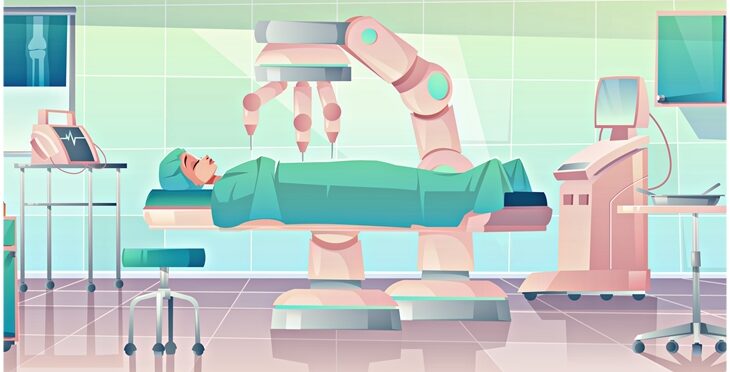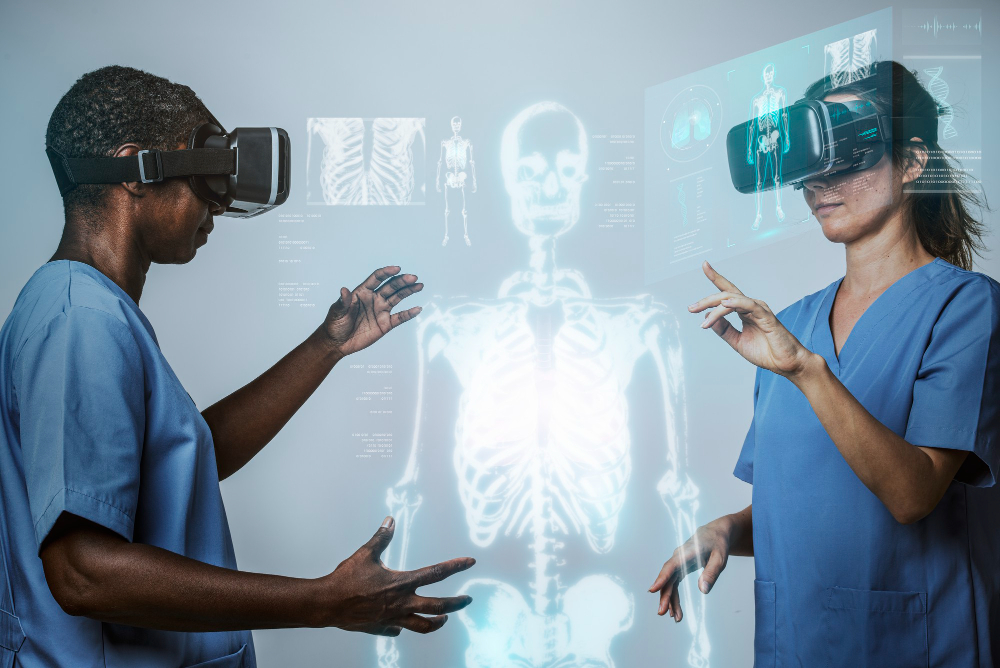Introduction
VR and Robotics in Medical Surgeries have been in use for more than a decade. It is all thanks to advances in computer technology. This is especially important when it comes to laparoscopic procedures. These procedures are often complicated and leave little room for error. With the introduction of robotic surgery and the development and widespread availability of a commercial surgical system, a good VR-assisted robotic surgery simulator could help to reduce the steep learning curve associated with many of these complex procedures, resulting in better outcomes. Such a simulation does not exist now. Several agencies and corporations but are working to make this dream a reality.
What is Robotic Surgery?
Robotic surgery is an innovation. A human surgeon controls a robotic device, such as a robotic arm, to perform surgery. As a result, there are fewer risks of complications during surgery, and the procedure is fast. The robotic device is precise. Thus it results in smaller incisions, less blood loss, and a quicker recovery time.
VR in Healthcare and Surgery

Surgery Training with VR
VR and Robotics in Medical Surgeries are being adopted in the healthcare industry. Particularly to train the next generation of medical professionals. This technology allows surgeons in training to gain valuable experience while remaining safe. They learn new skills and techniques without endangering patients and get constant feedback.
This boosts their confidence while also allowing helping them to gain experience. Surgical procedures in VR allow them to practice new techniques and brush up on old ones. Furthermore, they can correct their mistakes without endangering themselves or their patient.
VR in Robotic Surgery
The surgeon can control the robotic arm's movements using virtual reality. It enables them to perform small, delicate movements. Traditionally, that would be difficult for a human surgeon to do. Another application is 'remote telesurgery,' in which a surgeon in another location operates on the patient. To put it another way, he or she is not in the same room as the patient.
Force feedback is an important factor in this. It's the term for a set of physical reactions that a person has when using an interactive device. This device can be a joystick such as on a flight simulator. When performing robotic surgery, it is critical that the surgeon feels a physical response that tells them how much pressure to apply. As a result, they are able to make any necessary adjustments.
Benefits of Robotic Surgery
Robotic surgery is a laparoscopic or minimally invasive surgery A computer-controlled robot assists the surgeon during the procedure. The robot enhances the surgeon’s dexterity. This allows them to operate in small spaces inside the body that would otherwise need open surgery. Robotic surgery causes smaller incisions. This reduces pain and scarring. Also, the patient needs to spend less time in the hospital and faster recovery times.
Robotic surgery also benefits the surgeon. They gain increased precision, flexibility, control, and vision. It also enables them to carry out delicate or difficult surgical procedures.
Patient Benefits
For the patient, the benefits of robotic surgery include:
Surgery that is more precise. The goal of surgery is to remove the abnormality while preserving the health of the surrounding structures. The robotic instruments' small size and flexibility make this easier to achieve.
Significantly less discomfort.
Infection and blood loss are less likely. The surgeon uses small incisions instead of large ones. This reduces the risk of infection and blood loss.
Patients can usually go home sooner after robotic surgery, sometimes even the next day.
Less scarring and reduces recovery time. Because the incisions are smaller, your recovery time will be shorter. It's possible that recovery will only take a few days.
Better clinical outcomes in many cases.
Surgeon Benefits
For the surgeon, the benefits of robotic surgery include:
A wider field of vision. The surgeon has a better view of the operating room than the rest of the team. Surgeons get a magnified, detailed picture of the affected area with a high-definition camera. The surgeon will be able to see the microscopic structures more clearly. Thus, resulting in a more precise operation.
Dexterity that is unrivaled. A human hand has a limited range of motion. But, the robotic instrument outperforms the human hand in precision and range of motion. The arms have a full 360-degree rotational range. This enables the surgeon to operate in ways that would otherwise be impossible.
Access to difficult-to-reach locations. The surgeon can access difficult-to-reach areas. All thanks to the robot's increased flexibility and precision.
Best Robotic Surgery Systems Available Today
da Vinci by Intuitive Surgical
Using the da Vinci Surgical System, surgeons can perform a variety of minimally invasive procedures. It is a clinically validated system with high precision and accuracy. The system can be used for a variety of procedures. This includes minimally invasive cardiac, colorectal, gynecological, head and neck, thoracic, urological, and general surgery. The surgeon controls the Patient Cart's robotic devices. It includes various surgical instruments and a camera, using the Surgeon Console.
Ion by Intuitive Surgical
It's a robotic endoluminal system that allows surgeons to perform deep lung biopsies. It helps with minimally invasive surgical techniques. The robotic catheter assists physicians in reaching areas of interest. It does so by allowing them to navigate through small and intricate airways. Biopsy instruments like forceps and needles are inserted into the catheter and used as a guide to reaching the desired lung tissue. During the navigation process, Ion uses fiber optic shape-sensing technology. It allows robotic control of the catheter's position. When the catheter reaches the desired location, it locks in place. Thus providing the unprecedented stability required for biopsy precision. Ion's catheter rotates 180 degrees in all directions. This allows for fine-tuning in biopsy accuracy.
Mako by Stryker
The Mako System is a robotics-assisted surgical device. It can perform partial knee, total hip, and total knee procedures. The pre-operative planning process uses data from a CT scan to create a 3D model of the patient's bone structure. This allows for precise implant positioning. This results in a unique plan to the patient, which the physician can review before surgery. Modifications for optimal implant placement may be required, with data collected during the operation and applied to the CT scan model.
NAVIO by Smith & Nephew
The NAVIO surgical system also aids total knee replacement procedures. Bone mapping is accomplished during the operation rather than using preoperative CT scans. The surgeon uses this software model to position the implant and balance tissues before cutting bone. Based on the bone mapping, the surgeon then uses a robotics-assisted hand tool to guide the procedure.
Smith & Nephew recently collaborated on a module for the NAVIO Surgical System with Osso VR. Osso VR is a surgical training company. This module includes clinically supported virtual reality simulations of the procedure. They are designed for use by practicing surgeons and residents learning the robotics-assisted procedure.
Monarch by Auris Health
The robotics-assisted system includes a video game-like controller. The surgeon uses it to guide a flexible robotic endoscope through the lungs' branches. This system offers innovative new technology for performing lung endoscopic procedures. It provides continuous bronchoscope vision, computed guidance, and precise instrument control. It combines traditional endoscopic viewpoints with computer-assisted navigation based on patient-specific 3D models.
Conclusion
With the help of a robot, surgeons will be able to better plan operations. VR and Robotics in Medical Surgeries would improve their surgical field view. The robot, controlled by a virtual reality parallel system as a digital twin, can accurately image a patient using ultrasound. All the while removing the hand cramping or radiation exposure that human operators face.
But, even with all the advancements, we have a long way to go. The robot-human relationship needs to be perfected further. With the upcoming advances in tech, VR and robotics in medical surgeries would be a huge step forward.






